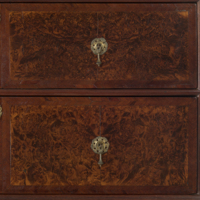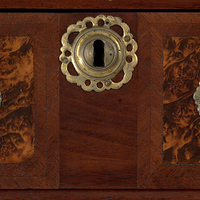Materials and Construction
Dublin Core
Title
Materials and Construction
Description
This high chest of drawers has a very distinct composition that tells us when and where it was produced. For instance, the center panel that divides the drawers is a good indicator of the Rhode Island origin. However, the brass escutcheons and pulls were always imported, usually from England, and were often the only part of the chest not made from American materials. The drop handles are typical of the time, and later evolved to u-shaped pulls. Other elements of the chest serve as clues to the time period as well, such as the legs of this ‘highboy.’ They are very clearly of the William and Mary style, consisting of distinct units known as inverted cups and trumpets. Most William and Mary high boys have six legs, four in the front and two in the back, always connected by a stretcher. The shape of this stretcher almost always mirrored the geometry of the ‘skirt,’ referring to the bottom portion of the chest. The high chest of drawers often came with a matching dressing table which was usually an exact copy of the skirt of the high chest. Above the skirt comes the portion of the High Chest of Drawers most closely related to its ancestor, the low chest. Each drawer decreases in depth from the bottom to the top. The front of each drawer is covered in burl veneer. Burl is made from the cross section of a knot on a tree. The slice would be stained to enhance the intricate grain pattern. This particular burl comes from a walnut tree and was most likely stained using Indian red, a popular pigment at the time. The drawers are formed using dovetail jointing, a technique brought from Europe to the colonies.
Files
Citation
“Materials and Construction ,” Unlocking Wonder: A peek into the world of luxury cabinets, accessed May 15, 2024, https://www.ats.amherst.edu/meadcollection/items/show/56.

